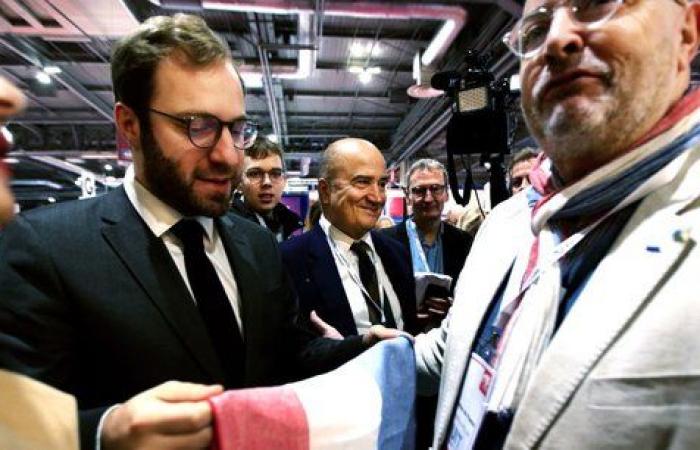
The MIF Expo exhibition held in Paris at the beginning of November demonstrated the interest (the organizers claim more than 100,000 visitors), even the love for clothing and textile products produced in France. However, only 3.3% of clothes purchased in France each year actually come from French sectors, according to the economic observatory of the IFM, the French Fashion Institute.
How to explain such a gap? The answer is in one word: price. A decisive factor for the consumer, whose purchasing power has been undermined by inflation, leading them to favor promotional operations, such as Black Friday which takes place on Friday November 29.
Made in France: “Producing textiles in France can become profitable again if volumes grow”
Textile initiatives made in France – particularly in the clothing segment – are now faced with a major challenge: becoming accessible, by reducing their costs. And this, in a context of competition exacerbated by the crazy growth of fast fashion, driven by brands like Shein.
“The main issue for made in France is indeed its competitiveness, with particular attention to labor costs. This is the whole debate on the production tax. But energy is also a subject, while on paper France has an incredible competitive advantage,” says Olivier Ducatillion, president of the Union of Textile Industries, which brings together 2,400 companies and 62,000 employees (including the textile sector). technical textile).
Like the deindustrialization that France experienced during the start of the 21st century, the textile manufacturing industry went from 400,000 employees in 1991 to just over 100,000 in 2018, according to a study by the INSEE. “ Between 1996 and 2015, it lost 51% of its production, 40% of its added value and 66% of its employed workforce. », According to the institute.
“Textile is a manual profession, the economic adjustment variable is therefore the cost of labor to be competitive (…). The whole challenge now for clothing made in France is to be accessible,” confirms Guillaume Gibault, the founder of Slip Français.
“Deindustrialization was indeed an ideological decision” (Anne-Sophie Alsif, economist)
Getting rid of the high-end label
Founded in 2011, this company which designs men's underwear made in France attacked the market with a piece at 40 euros each. Its turnover reached 20 million euros in the early 2020s.
« But since 2022, due to a difficult economic context, we have seen our turnover decrease by 10% per year. There is not an infinite market for high-end briefs. You have to sell it cheaper », notes the entrepreneur. His solution? Automate the production process.
Le Slip Français thus invested in a tool, to the tune of 15,000 euros. It allows him to automatically close the waistband of the briefs, an operation previously manual. All in a new production unit in the Paris region which brings together 30 employees (out of a total of 70). The company, which works with 40 French suppliers of raw materials and as many French manufacturers, must sell 400,000 pieces at 29 euros per unit in 2024 to envisage a peaceful future.
“No company in France had this machine. We are in the process of acquiring the third. It’s a significant risk, but we are demonstrating that there are solutions for made in France through automation,” rejoices Guillaume Gibault, who now has a production capacity of 12,000 products per week.
Clothing must move away from this image of a high-end and inaccessible product for a majority of consumers. This image is also shared by foreign consumers, as demonstrated by a recent opinion survey commissioned by CCI France.
“French textiles were saved by luxury, it must be recognized, but that locked us into this positioning of a high-end product. We have abandoned an entire part of the sector, the one capable of making products at affordable prices. However, the idea that the cost of labor in France determines the price is completely false! We can be competitive with a very short distribution circuit. We are three times cheaper in distribution than certain brands. And what we save on this marketing and distribution part, we invest in made in France”, explains Thomas Huriez, the founder and CEO of the jeans brand made in France 1083 which is trying to re-establish a textile ecosystem around its Company.
The entrepreneur says he produces 50,000 jeans totally made in France per year, with part of the production internalized, for a selling price of 99 to 159 euros. This strategy allows it to achieve eight million euros in turnover (60% from its website). An industrial performance achieved with the skills of around a hundred employees, half of whom are dedicated to production.
« We are lucky to still have textile schools in France, we must promote these professions. We call a multitude of professions in factories 'operators', it's a certain lack of respect… », Underlines the manager.
One million retirements: the challenge for French industry
Environmental footprint, a lifeline?
While it's been a question of supply so far, demand is also part of the equation. Many made in France players believed in the opportunity of the 2024 Olympic Games for public procurement to be an accelerator of growth. When it comes time to take stock, disappointment dominates.
« The Olympics are a failure even though the objective was for 20% of textile needs to be supplied locally, in France. The sector needs public procurement, more than subsidies », Calls Olivier Ducatillion of the Union of Textile Industries.
« Europe is often blamed for all the problems, but there is a real issue around public procurement for our companies. The industry needs visibility and these markets can provide it. The public authorities have not yet understood this », tackles Thomas Huriez for his part. The government, through Marc Ferracci, Minister of Industry, is awaiting a dedicated report, before changing its doctrine on the matter.
“Textiles made in France are at best on a plateau, at worst in a phase of decline. What can save it is legislation around the environmental footprint, but that will take time,” observes Olivier Ducatillion.
In this sense, the Minister of Ecological Transition, Agnès Pannier-Runacher, was traveling to the French Fashion Institute, in Paris, this Thursday morning. Objective: launch the last public consultation on the system aimed at informing consumers of the environmental cost of their purchases. “ Displaying the environmental cost (on labels, Editor's note) will ultimately allow the French to quickly know if the product they wish to buy is more or less ecologically virtuous. », Underlines his ministry.
“France wants to be ahead of this subject and apply it from 2025. If French display is accompanied by a certain form of financial bonus-malus, it will be very interesting for the sector (…). Europe is moving forward in parallel on its own environmental labeling. There are discussions about calculation methods. But the European method plans to favor polyester clothing, in other words fast fashion, and not organic cotton or wool, materials on which the French industry is positioned,” warns Guillaume Declair, co-founder of the Loom brand and the movement. En Mode Climat, which participates in French work on the subject.
Finally, there remains the thorny issue of the collection tax credit (CIC), a tax support of 40 million euros threatened in the draft finance law (PLF) 2025. This tax tool mainly benefits SMEs in the textile sector in France and encourages innovation. “ This is the only competitiveness argument we have left in our sector for France! », Worries the president of the Union of Textile Industries, 80% of whose members benefit from it. Verdict in the days to come.





